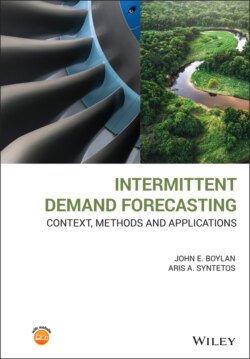Читать книгу Intermittent Demand Forecasting - John E. Boylan - Страница 78
3.5.1 Distribution of Demand Over One Time Period
ОглавлениеA ‘demand distribution’ assigns a probability to each of the possible values of demand over a specified period of time. An example of a distribution of demand for an SKU over one week is shown in Table 3.2. The distribution assigns a probability of 0.5 to 0, indicating that the SKU is intermittent and we expect 50% of future weeks to contain no demand, and similarly assigns probabilities of 0.3 and 0.2 to demands of one and two units, respectively. According to this distribution, there will never be demand for three or more units over a period of one week, as the probability of this eventuality is zero.
The distribution in Table 3.2 may be represented physically by an icosahedral die of 20 faces, with the numbers on the faces representing the possible demand values. The values should be shared out amongst the 20 faces in direct proportion to the probabilities shown in Table 3.2. So, there would be 10 faces showing zero, six faces showing one, and four faces showing two.
The icosahedral die is a convenient way to visualise probabilities but suffers from the limitation that a 20‐sided die can represent only those chances that are multiples of 0.05, because each side represents a chance of 1/20. Probabilities such as 0.02 cannot be represented. In practice, we can replace a physical die with a virtual one, and use software to generate random numbers to the required level of resolution.
In this chapter, we make two important assumptions, which correspond to the representation of chance events by a physical or virtual die:
1 Independent: The probability of demand in one period does not depend on the demand in previous periods (as each roll of the die is independent of previous rolls). This may not always be true in practice if ‘streaks’ of non‐zero demands are observed more frequently than would be expected if demands were truly independent.
2 Identically distributed: The probabilities are not changing over time (as the faces on the die do not change). In practice, it is possible that the chance of a zero demand may decrease or increase over time. For example, as original equipment is withdrawn from production, the demand for spares will eventually decline, leading to a higher chance of zero demand.
For the remainder of this chapter, these two assumptions are maintained. In Chapters 6 and 7, we look at situations where demand is not identically distributed over time. In Chapters 13 and 14, we examine non‐independent demand processes leading to streaks of demand.
In addition to the two assumptions of independence and identical distribution over time, we also make a third assumption:
1 Non‐negative: Demand cannot be negative, although it can be zero.
This is a natural assumption for demand itself, although it is not appropriate for ‘net demand’, which is found by subtracting returns from demand (Kelle and Silver 1989). This is relevant in closed‐loop supply chains where items are returned for refurbishment or remanufacturing.
